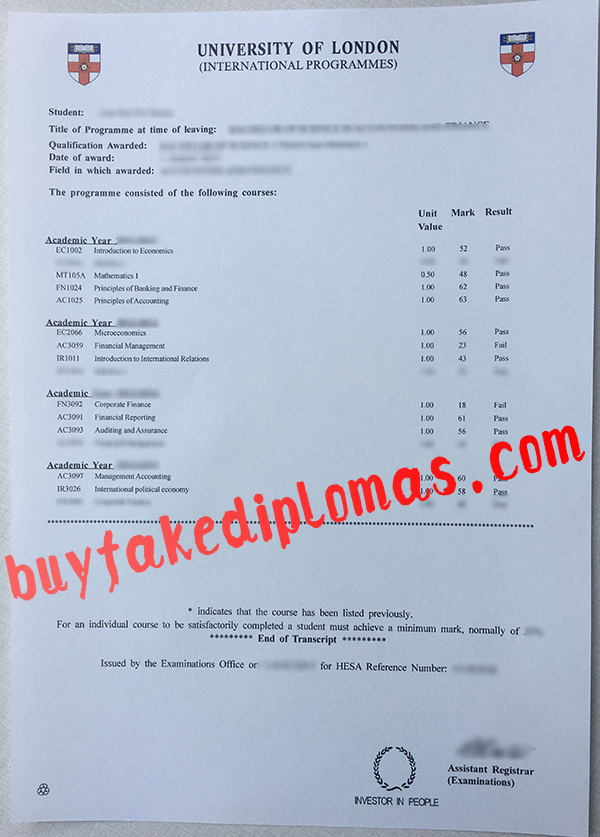We provide the best service at the most favorable price in the market. The original stamps / stickers, perfect and authentic seal and badge samples help you obtain the ideal certificate add our whatsapp: +86 15179517591
Whose Fake University of London International Programmes Transcript Is The Best Quality?

University of London International Programmes Transcript
The University of London was founded in 1836 by the merger of University College London and King’s College London, with a royal charter signed by King William IV. Ucl did not yet have a royal charter; King’s College London had been granted a royal charter in 1829, when it admitted only Anglican students. buy fake University of London International Programmes diploma, King’s College and University College London were both established earlier than University College London in 1826 and King’s College London in 1829 when the University of London was simply a joint examination institution for the two schools. In 1858, buy fake University of London International Programmes Transcript, buy fake University of London International Programmes degree, the University of London International Programmes & mdash; & mdash; It was the first project of its kind in British history, and its remit began to expand. The University of London began building its own headquarters, exam centre and offices in Burlington Gardens. In 1878 the University of London was the first to admit women. In 1880 four women were awarded the Bachelor of Arts degree and in 1881 two women were awarded the Bachelor of Science Degree. mdash; & mdash; Both were the first of their kind in Britain. In 1898, the University of London’s status as a mere examination centre began to attract criticism. Critics argue that the University of London should exist not only as an examination centre for its members, buy fake University of London International Programmes certificate. but should also set and regulate academic, educational and curriculum standards for its members. In the same year, the University of London passed the first act in its history, which established the management status of the University of London and established the governing body and Council of the University of London, so that King’s College London and University College London officially became members of the University of London. The change in status meant that the university needed more space for offices, and 6 Burlington Gardens had to be abandoned. Whose Fake University of London International Programmes Transcript Is The Best Quality?
In the 20th century, the University of London experienced rapid development. Bedford College, Royal Holloway College and the London School of Economics joined in 1900; In 1901, Regents Park College, formerly affiliated with University College London, became an official seminary of the University of London. In 1904 Goldsmiths College was added; Imperial College joined in 1907; In 1915 Queen Mary College joined; In 1916, SOAS joined; Birkbeck College joined in 1920. As universities expand rapidly, the headquarters of the University of London will have to be moved again because of its small size. This time, the University of London decided to build a permanent headquarters that could accommodate any expansion of the university. Senate House, the second largest building in the city of London, was eventually located next to the Royal School of Needlework. During the Second World War, the other colleges of the University of London, except Birkbeck College, moved away from London to escape the fighting. The Council House was requisitioned by British intelligence and its roof was used to warn of enemy bombing. Despite repeated bombings, the building has survived unscathed, and there are rumors that Hitler spared no one because he wanted to use it as a future residence.
The second half of the 20th century was an uneventful half-century for the University of London. But its colleges, notably University College London, King’s College London, the London School of Economics and Imperial College London, have periodically begun to discuss leaving the University, slowly raising concerns about its future. In 2002, Imperial College London and University College London began to discuss merging into a single university, but the idea was rejected by both students and staff. On 5 December 2005, Imperial College London announced that it would leave the University of London in 2007 to celebrate its 100th anniversary and become an independent university. On 5 October 2006, the University of London passed a resolution granting Imperial College independence from the University of London, and on 9 July 2007, Imperial College officially separated from the University of London to become a fully independent institution on the 100th anniversary of its establishment. Imperial’s departure has left London University, especially its smaller colleges, in a state of uncertainty. In February 2007 (imperial had not yet been formally to leave, but that is set in stone) at university college London, London school of economics, at king’s college London in The Times higher education “formally issued a statement, said the three schools decided not to leave the university of London, but at the same time decision from September 2007 freshmen began to issue his college degree. The decision does not dispel concerns about the fate of the University of London, and in a sense has intensified them. Meanwhile, the University of London has continued to grow, with the Central School of Speech and Drama joining the university in 2005. Membership List The main administrative offices of the University of London are located in Bloomsbury, London, near the Council House in Russell Square. It is also home to the University of London’s headquarters campus, which includes eight halls of residence, a council house, a library and the Vice-Chancellor’s office. The School of Advanced Study is also largely located here.
